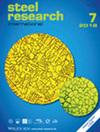Modeling of Arcing, Scrap Melting, and Temperature Evolution in the Refractory of a Lab‐Scale Direct Current‐Electric Arc Furnace
IF 1.9
3区 材料科学
Q2 METALLURGY & METALLURGICAL ENGINEERING
引用次数: 0
Abstract
Refractory linings of electric arc furnaces are subjected to intense thermal loads, leading to occasional failure of the insulating bricks. A numerical model that simulates the phenomena of arcing, scrap melting, and the transient thermal evolution in the refractory lining of a laboratory‐scale direct current‐electric arc furnace (DC‐EAF) is developed. The rise in the temperature of the refractory lining depends on many factors, including the duration of the melting operation, the intensity and duration of arcing, the design of the furnace, thermophysical properties, and the thickness of the lining. Continuum formulation‐based equations for the transport of momentum, energy, and species, auxiliary models of phase changes associated with scrap melting and evaporation of metal under the arc and Maxwell's equations are solved in a conjugate domain to model the progress of the melting of the scarp and temperature evolution in the refractory lining. Combining experimental data from lab‐scale DC‐EAF, the model is enhanced to represent the laboratory experiment. Scrap with high porosity needs more time for melting, and thermal damage of refractory lining is linked to prolonged arcing coupled with the poor quality of refractory materials.实验室规模直流电弧炉耐火材料中的电弧、废料熔化和温度变化建模
电弧炉的耐火衬承受着强烈的热负荷,导致绝缘砖偶尔失效。本研究开发了一个数值模型,用于模拟实验室规模的直流电弧炉(DC-EAF)耐火衬的起弧、废料熔化和瞬态热演变现象。耐火内衬温度的升高取决于许多因素,包括熔化操作的持续时间、电弧的强度和持续时间、熔炉的设计、热物理性质以及内衬的厚度。我们在共轭域中求解了基于连续公式的动量、能量和物种传输方程,与电弧下金属废料熔化和蒸发相关的相变辅助模型,以及麦克斯韦方程,以模拟疤痕的熔化过程和耐火衬里的温度变化。结合实验室规模 DC-EAF 的实验数据,增强了模型对实验室实验的代表性。孔隙率高的废料需要更长的熔化时间,耐火衬的热损伤与长时间电弧和耐火材料质量差有关。
本文章由计算机程序翻译,如有差异,请以英文原文为准。
求助全文
约1分钟内获得全文
求助全文
来源期刊

steel research international
工程技术-冶金工程
CiteScore
3.30
自引率
18.20%
发文量
319
审稿时长
1.9 months
期刊介绍:
steel research international is a journal providing a forum for the publication of high-quality manuscripts in areas ranging from process metallurgy and metal forming to materials engineering as well as process control and testing. The emphasis is on steel and on materials involved in steelmaking and the processing of steel, such as refractories and slags.
steel research international welcomes manuscripts describing basic scientific research as well as industrial research. The journal received a further increased, record-high Impact Factor of 1.522 (2018 Journal Impact Factor, Journal Citation Reports (Clarivate Analytics, 2019)).
The journal was formerly well known as "Archiv für das Eisenhüttenwesen" and "steel research"; with effect from January 1, 2006, the former "Scandinavian Journal of Metallurgy" merged with Steel Research International.
Hot Topics:
-Steels for Automotive Applications
-High-strength Steels
-Sustainable steelmaking
-Interstitially Alloyed Steels
-Electromagnetic Processing of Metals
-High Speed Forming
 求助内容:
求助内容: 应助结果提醒方式:
应助结果提醒方式:


